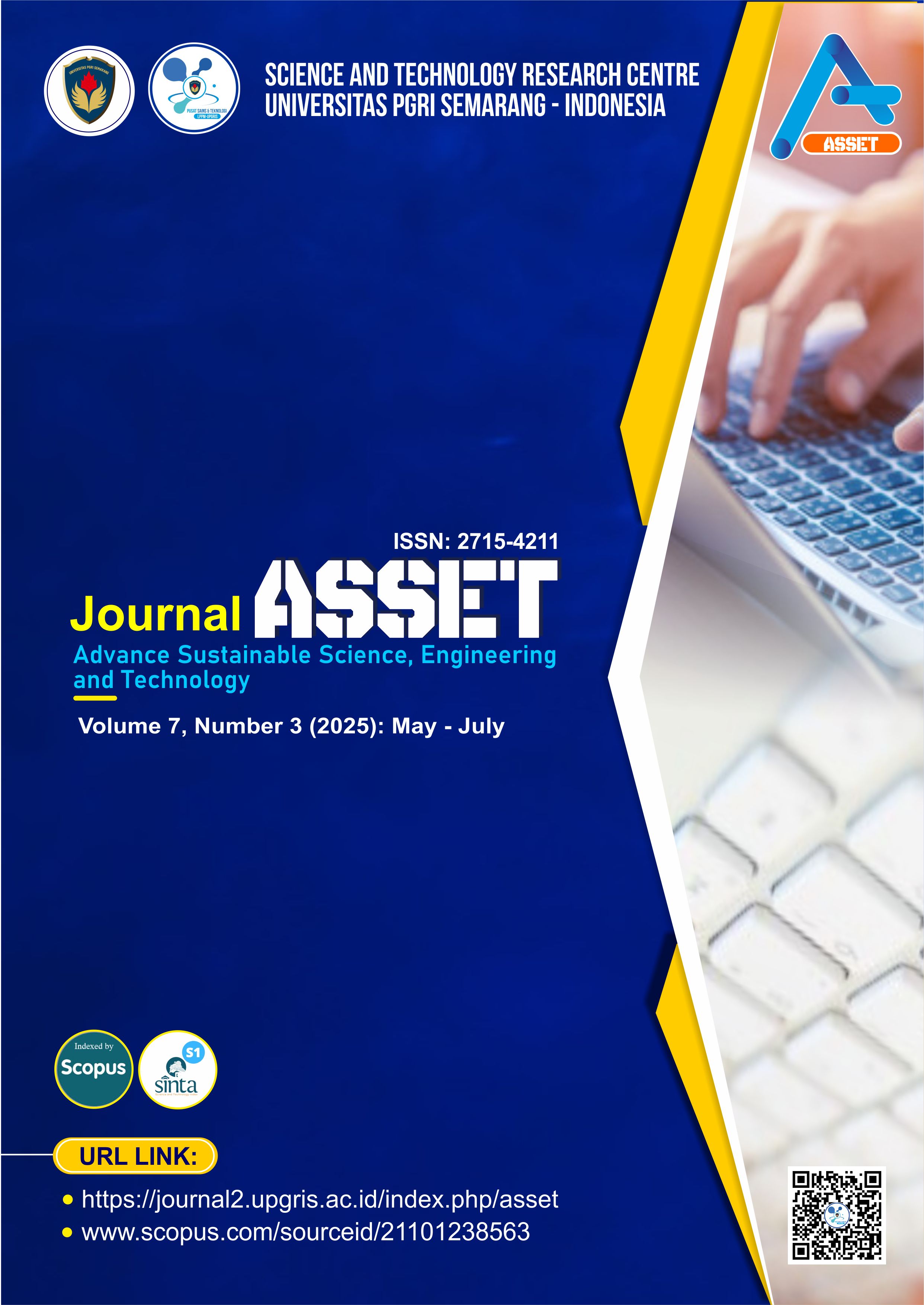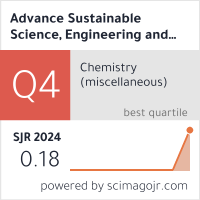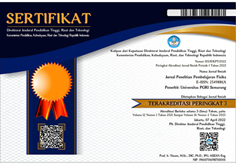Development of an IoT-based Soil Nutrient Monitoring and GIS Mapping System for Precision Agriculture
DOI:
https://doi.org/10.26877/asset.v7i4.2191Keywords:
geographic information system, internet of things, precision agriculture, real-time monitoring, soil nutrientAbstract
Agriculture is a field that contributes to Indonesia's economic development. Unpredictable weather, temperature fluctuations, and the difficulty in assessing soil quality hinder farmers in enhancing crop productivity. The IoT in signifies a beneficial progression that will assist farmers in their endeavors. Precision agriculture is an innovative approach that employs information technology for sustainable agricultural management. This research aims to assess soil nutrients and provide mapping data based on the evaluated agrarian sites. The testing sites are situated in three sub-districts within Kubu Raya Regency: Sungai Kakap, Ambawang, and Rasau Jaya. The soil study indicated a temperature range of 29.40 °C to 36.80 °C. Soil moisture varied from 4 % to 89.10 %. The soil pH varied between 6.90-8.07 PH. The soil salinity was rather modest. Nutrient levels, particularly nitrogen, were slightly lower than those of phosphate and potassium, necessitating fertilizer use to enhance plant vegetative development. Incorporating the Internet of Things onto agricultural land delivers data as real-time monitoring, which will be essential for improving agricultural output. This scalable method mitigates contemporary agricultural difficulties by diminishing environmental impact and enhancing crop resilience. This study facilitates sustainable, intelligent agricultural techniques to address the escalating needs of a swiftly expanding global population.
References
[1] A. Saleem, S. Anwar, T. Nawaz, S. Fahad, S. Saud, T. U. Rahman, M. N. R. Khan and T. Nawaz, “Securing a sustainable future: the climate change threat to agriculture, food security, and sustainable development goals,” Journal of Umm Al-Qura University for Applied Sciences, vol. 11, no. 3, pp. 595–611, Sep. 2025, doi: 10.1007/s43994-024-00177-3.
[2] K. Gasparini, D. D. Rafael, L. E. P. Peres, D. M. Ribeiro, and A. Zsögön, “Agriculture and Food Security in the Era of Climate Change,” in Digital Agriculture, Cham: Springer International Publishing, 2024, pp. 47–58. doi: 10.1007/978-3-031-43548-5_2.
[3] I. Khan, H. Lei, A. A. Shah, I. Khan, and I. Muhammad, “Climate change impact assessment, flood management, and mitigation strategies in Pakistan for sustainable future,” Environmental Science and Pollution Research, vol. 28, no. 23, pp. 29720–29731, Jun. 2021, doi: 10.1007/s11356-021-12801-4.
[4] S. Gashure, “Impacts of climate variability and adaptation strategies on staple crop productivity in Sidama, Ethiopia,” Sci Rep, vol. 15, no. 1, p. 27461, Jul. 2025, doi: 10.1038/s41598-025-11880-4.
[5] Y-D. Wu, Y-G. Chen, W-T. Wang, K-L. Zhang, L-P. Luo, Y-C. Cao and P-K. Jiang, “Precision Fertilizer and Irrigation Control System Using Open-Source Software and Loose Communication Architecture,” Journal of Irrigation and Drainage Engineering, vol. 148, no. 6, Jun. 2022, doi: 10.1061/(ASCE)IR.1943-4774.0001669.
[6] P. Sankarasubramanian, “Enhancing precision in agriculture: A smart predictive model for optimal sensor selection through IoT integration,” Smart Agricultural Technology, vol. 10, p. 100749, Mar. 2025, doi: 10.1016/j.atech.2024.100749.
[7] C. M. Onyango, J. M. Nyaga, J. Wetterlind, M. Söderström, and K. Piikki, “Precision Agriculture for Resource Use Efficiency in Smallholder Farming Systems in Sub-Saharan Africa: A Systematic Review,” Sustainability, vol. 13, no. 3, p. 1158, Jan. 2021, doi: 10.3390/su13031158.
[8] E. Mamabolo, M. J. Mashala, E. Mughari, T. E. Mogale, N. Mathebula, K. Mabitsela and K. K. Ayisi, “Application of precision agriculture technologies for crop protection and soil health,” Smart Agricultural Technology, vol. 12, p. 101270, Dec. 2025, doi: 10.1016/j.atech.2025.101270.
[9] Y. Mulat, K. Kibret, B. Bedadi, and M. Mohammed, “Soil quality evaluation under different land use types in Kersa sub-watershed, eastern Ethiopia,” Environmental Systems Research, vol. 10, no. 1, p. 19, Dec. 2021, doi: 10.1186/s40068-021-00224-6.
[10] E. J. Mba, F. O. Okeke, A. E. Igwe, O. J. Ebohon, and F. C. Awe, “Changing needs and demand of clients vs ability to pay in architectural industry,” Journal of Asian Architecture and Building Engineering, pp. 1–24, Jan. 2025, doi: 10.1080/13467581.2025.2455039.
[11] K. Sharma and S. K. Shivandu, “Integrating artificial intelligence and Internet of Things (IoT) for enhanced crop monitoring and management in precision agriculture,” Sensors International, vol. 5, p. 100292, 2024, doi: 10.1016/j.sintl.2024.100292.
[12] D. Ather, S. Madan, M. Nayak, R. Tripathi, R. Kant, S. S. Kshatri and R. Jain, “Selection of Smart Manure Composition for Smart Farming Using Artificial Intelligence Technique,” J Food Qual, vol. 2022, pp. 1–7, May 2022, doi: 10.1155/2022/4351825.
[13] R. K. Srivastava, S. Purohit, E. Alam, and M. K. Islam, “Advancements in soil management: Optimizing crop production through interdisciplinary approaches,” J Agric Food Res, vol. 18, p. 101528, Dec. 2024, doi: 10.1016/j.jafr.2024.101528.
[14] M. R. Islam, K. Oliullah, M. M. Kabir, M. Alom, and M. F. Mridha, “Machine learning enabled IoT system for soil nutrients monitoring and crop recommendation,” J Agric Food Res, vol. 14, p. 100880, Dec. 2023, doi: 10.1016/j.jafr.2023.100880.
[15] J. Sardans and J. Peñuelas, “Potassium Control of Plant Functions: Ecological and Agricultural Implications,” Plants, vol. 10, no. 2, p. 419, Feb. 2021, doi: 10.3390/plants10020419.
[16] M. R. Thakur, V. M. Bhale, and A. N. Paslawar, “Mobility of N, P and K and root growth of Bt and nonBt cotton in clayey soil under different NPK levels,” Ecology, Environment and Conservation, vol. 28, pp. 419–424, 2022, doi: 10.53550/EEC.2022.v28i07s.069.
[17] A. Hachem, F. Convertino, T. Batista, F. Baptista, D. Briassoulis, D. L. V. Martinez, M. A. M. Teruel, L. Nizzeto, N. G. Papardaki, G. Ruggiero, G. Vox and E. Schettini, “GIS mapping of agricultural plastic waste in southern Europe,” Science of The Total Environment, vol. 946, p. 174491, Oct. 2024, doi: 10.1016/j.scitotenv.2024.174491.
[18] E. Avşar and Md. N. Mowla, “Wireless communication protocols in smart agriculture: A review on applications, challenges and future trends,” Ad Hoc Networks, vol. 136, p. 102982, Nov. 2022, doi: 10.1016/j.adhoc.2022.102982.
[19] B. B. Sinha and R. Dhanalakshmi, “Recent advancements and challenges of Internet of Things in smart agriculture: A survey,” Future Generation Computer Systems, vol. 126, pp. 169–184, Jan. 2022, doi: 10.1016/j.future.2021.08.006.
[20] R. Manikandan, G. Ranganathan, and V. Bindhu, “Deep Learning Based IoT Module for Smart Farming in Different Environmental Conditions,” Wirel Pers Commun, vol. 128, no. 3, pp. 1715–1732, Feb. 2023, doi: 10.1007/s11277-022-10016-5.
[21] P. Tan, E. T. Gebremariam, M. S. Rahman, H. Salman, and H. Xu, “Design and Implementation of Soil Moisture Monitoring and Irrigation System based on ARM and IoT,” Procedia Comput Sci, vol. 208, pp. 486–493, 2022, doi: 10.1016/j.procs.2022.10.067.
[22] R. Hartono, N. Maulana Yoeseph, F. Aji Purnomo, M. Asri Safi’ie, and S. Alim Tri Bawono, “Portable internet of things-based soil nutrients monitoring for precision and efficient smart farming,” Bulletin of Electrical Engineering and Informatics, vol. 13, no. 5, pp. 3326–3333, Oct. 2024, doi: 10.11591/eei.v13i5.7928.
[23] C.-Y. Chen, S.-H. Wu, B.-W. Huang, C.-H. Huang, and C.-F. Yang, “Web-based Internet of Things on environmental and lighting control and monitoring system using node-RED, MQTT and Modbus communications within embedded Linux platform,” Internet of Things, vol. 27, p. 101305, Oct. 2024, doi: 10.1016/j.iot.2024.101305.
[24] R. Aarthi, D. Sivakumar, and V. Mariappan, “Smart Soil Property Analysis Using IoT: A Case Study Implementation in Backyard Gardening,” Procedia Comput Sci, vol. 218, pp. 2842–2851, 2023, doi: 10.1016/j.procs.2023.01.255.
[25] E. B. El Hakim and J. Aryanto, “Automated Maintenance System For Freshwater Aquascape Based On The Internet Of Things (Iot),” Advance Sustainable Science, Engineering and Technology, vol. 6, no. 1, p. 02401024, Jan. 2024, doi: 10.26877/asset.v6i1.17951.
[26] H. Shahab, M. Naeem, M. Iqbal, M. Aqeel, and S. S. Ullah, “IoT-driven smart agricultural technology for real-time soil and crop optimization,” Smart Agricultural Technology, vol. 10, p. 100847, Mar. 2025, doi: 10.1016/j.atech.2025.100847.
[27] Y. Ding, H. Lu, L. Xu, R. Horton, M. Jiang, Y. Zhu, J. Cheng, H. Fan and J. Su, “Estimating the groundwater table threshold for mitigating soil salinization in the Songnen Plain of China,” J Hydrol Reg Stud, vol. 59, p. 102326, Jun. 2025, doi: 10.1016/j.ejrh.2025.102326.
[28] L. Dai, J. Ge, L. Wang, Q. Zhang, T. Liang, N. Bolan, G. Lischeid, and J. Rinklebe, “Influence of soil properties, topography, and land cover on soil organic carbon and total nitrogen concentration: A case study in Qinghai-Tibet plateau based on random forest regression and structural equation modeling,” Science of The Total Environment, vol. 821, p. 153440, May 2022, doi: 10.1016/j.scitotenv.2022.153440.
[29] J. Kalonga, K. Mtei, B. Massawe, A. Kimaro, and L. A. Winowiecki, “Characterization of soil health and nutrient content status across the North-East Maasai Landscape, Arusha Tanzania,” Environmental Challenges, vol. 14, p. 100847, Jan. 2024, doi: 10.1016/j.envc.2024.100847.
[30] M. Desalegn, “Assessment and Mapping of Soil Fertility Status of Migna Kura Kebele, Wayu Tuka District, East Wollega, Oromia, Ethiopia,” Asian Soil Research Journal, vol. 8, no. 1, pp. 8–32, Jan. 2024, doi: 10.9734/asrj/2024/v8i1142.
[31] K. Negacz, Ž. Malek, A. de Vos, and P. Vellinga, “Saline soils worldwide: Identifying the most promising areas for saline agriculture,” J Arid Environ, vol. 203, p. 104775, Aug. 2022, doi: 10.1016/j.jaridenv.2022.104775.











